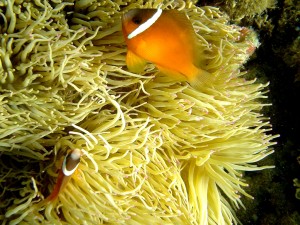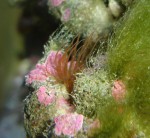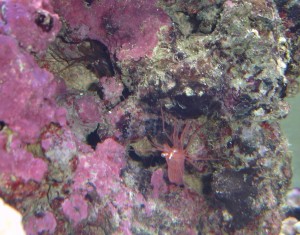When I think of sea anemones, I think of waving tentacles, in brilliant colors. Something that would sting me if I got too close. I also think of a small clown fish family darting in and out of the anemone, daring larger fish to come get them.
I hope to put an anemone like this in a reef aquarium some day. But, it turns out there are other types of anemone that are a real pest. And lucky me, I had a few of these come up recently.
The most prevalent type of pest anemone is Aiptasia, also known as Glass Anemone. This is exactly what I had. It started out as about 3 Glass Anemone on one of the new live rocks. The fish store warned me about these clear tentacled things that were already visible on the rock when I purchased it. They scraped the ones they saw off with a flat screwdriver before I even brought the live rock home.
Unfortunately, Glass Anemone are not that easy to get rid of. A few more popped up a day or two after the live rock was in its new home. I tried a few times to remove the offending rock and scrape off the new Glass Anemones. But, they just kept coming back.
You see, Aiptasia is a very prolific little anemone. When a small chunk of an Aiptasia separates from a larger one, the small chunks will turn into full-fledged Aiptasia. When they sense danger (like someone sticking a flat screwdriver in them) the Glass Anemone will squirt out its own small chunks. So even if you suck them out completely, chances are you’ve created 30 or 40 baby Aiptasia that will show up in a few weeks. They can quickly overrun an aquarium. Worse, they tend to sting coral that’s close to it, and can kill off the coral you really want.
What could I do? I only had about 8 visible Glass Anemones, but I knew they could become a big problem. So, I did what any self-respecting geek would do – I read about them on the Internet. This wasn’t as easy as you might think. Since I didn’t know the official name at the time, I had to try to describe them in a Google search. Searches like “brown tentacle coral” brought up nothing (but, perhaps it will now :-)). I even tried searching my normal coral identifying web sites to see if I could visually identify these strange marine invertebrates. Oddly, no one seems to want to show off their beautiful Glass Anemones.
I finally found the name by going back to the fish store, finding some in their display tank, and pointing. They identified it as Glass Anemone, and suggested some screwdriver time under the faucet. When that didn’t work, I started researching Glass Anemone on the Internet, and found lots of ideas of how to take care of the problem. The most interesting ideas follow:
- Use a specialized Aiptasia elimination product, like Aiptasia-X
- Introduce an animal that thinks Aiptasia is a delicacy
- Squirt boiling hot fresh (RO/DI) water into the anemone’s base with a syringe
- Squirt vinegar into the Aiptasia’s oral cavity (Don’t do this – it can throw your pH out of whack, since vinegar is an acid)
I choose to combine the first two suggestions. I purchased Aiptasia-X, and three Peppermint Shrimp.
Unfortunately, I can’t report on the effectiveness of the Aiptasia-X, because the shrimp are too darn effective! I introduced the shrimp on Saturday. By Monday morning, all the Aiptasia was gone, including the larger specimens. I don’t believe the fight is over, because of the way they reproduce. But, I believe the shrimp will be very effective at keeping the small Glass Anemones under control.
The Peppermint Shrimp are actually quite entertaining as well. When I first introduced them to the aquarium, one of them attached itself to may hand, and appeared to start eating dead skin. He’s an effective swimmer, so it was actually a little challenging getting him off. During the day they hide in tiny caves and crevices in the live rock. I normally see them hanging upside down and swaying back and forth. We’ve decided to call them Larry, Moe, and Curly, even though one of them is definitely female.
There are a few more animals that eat Aiptasia. Many people sugest Copperband Butterfly Fish. I didn’t like this option, because they can nip at other corals in the aquarium. I also understand they are finicky eaters, so just getting them eating in general can be a challenge.
Another popular choice is a type of sea slug called Berghia. The only issue I have with Berghia is that they only eat Aiptasia, and will die when they finish cleaning the aquarium. The Peppermint Shrimp, on the other hand, will eat algae just as happily as Glass Anemones. I have heard that Peppermint Shrimp can nip at corals as well, but most people suggest that behavior is not from Peppermint Shrimp, but another type of shrimp. There is a similar looking shrimp called a Camelback Shrimp, that will eat Aiptasia, but also many other kinds of coral. So, make sure you get the right kind of shrimp.
If you’re still curious about Aiptasia-X, this blog describes how it’s used. I will report back if I get the opportunity to try it.



Great article! this is so informative.